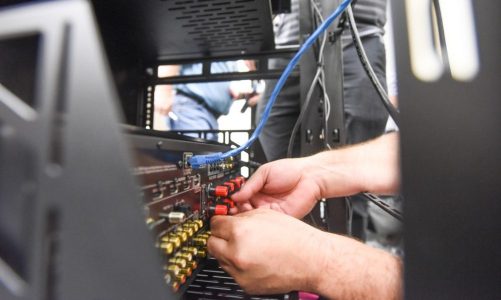The Cabling and Infrastructure Technician (CIT) and Integrated Systems Technician (IST) are core elements of CEDIA’s workforce development strategy. These ANSI/ISO-accredited certifications, supported by vetted training and preparation programs and textbooks, get us in the door with parents, teachers, and program administrators. Inside our own industry, however, many integrators underestimate the value of CEDIA certification for their businesses.
My colleague Paul Skelton recently conducted some revealing market research. Nearly all the integrators he surveyed recognize that the industry needs strong certifications – but they aren’t personally willing to pursue certification. Where is this belief – that “certification is great, but not for me” – coming from? Based on my conversation with Paul and integrators Amanda Wildman, Mike Ranpura, and Pete Trauth at ISE, there are a lot of myths about certification that persist in the industry. If we’re going to attract the next generation of talent and seize the opportunities before us, we need to dispel those myths now.
Myth #1 – It Doesn’t Matter Whether You’re Certified
Certification carries a lot of weight with allied trades who have a strong tradition of certification, licensing, and continuing education. Electricians, architects and engineers recognize the meaning of ANSI/ISO accreditation, and are far more likely to seek to engage with partners who can verify their expertise to an accepted standard.
“Every day, I speak with architect associations, builder groups, and government agencies. The conversations always follow the same path,” says Paul Skelton, Regional Development Consultant for CEDIA in Australia and New Zealand. “They’re excited about the industry, but they want to know how they can tell whether an integrator is qualified.”
CEDIA’s globally-accredited certifications are the answer to that question. When subcontracting to an allied trade, having multiple certified staff members gives you a crucial competitive edge. As part of the bigger picture, a critical mass of certified integrators will prove to allied trade groups, government agencies and lawmakers that this industry holds itself to rigorous, defined standards.
Myth #2 – You Don’t Need Certification If You Have Experience
Do you want the next generation of home technology professionals to value precision, expertise, and standards? Then lead by example.
Pete Trauth, CIT-SME, IST-SME, ESC-T, ESC-N, ESC-D, Owner of Nirvana Home Entertainment, once told me, “I can’t ask my staff to commit to certification if I don’t first commit to it.” As the banner of letters behind his name attests, he has committed fully – and found personal growth in the process.
Certification is a journey that doesn’t end with passing the test. CIT and IST holders must renew every three years by refreshing their knowledge with any new material that’s been added to the exam content outline. Maintaining a certification demonstrates your determination to stay on the industry’s leading edge.
“There’s a difference between ‘years in the industry’ and ‘experience,’” says Trauth. “You can do the same things over and over again, but you don’t grow from that. Certification keeps you up to date. Keeping your learning going throughout your career is what builds real experience.”
Myth #3 – You Don’t Have Time to Train for Certification
Training your staff does not cost nearly as much time as not training your staff. You may arrive at a project with a clear plan and explicit instructions for inexperienced staff members, but things can change quickly on site. When the drawing doesn’t match the build, can your technicians make the right call?
“When a new person makes unsupervised decisions on a job site, a single mistake can cost a lot of money and time in rework,” says Amanda Wildman, ESC, CIT-SME, IST-SME, Owner of TruMedia and CEDIA Board Secretary. “CIT helps define what decisions a technician is qualified to make, and what decisions require approval or oversight from an ISE-certified staff member.”
Often, time spent in training is repaid with onsite effectiveness:
“I have dedicated study days for my newest hire, preparing him to take the CIT,” says Mike Ranpura, CIT-SME, IST-SME, ESC-T, ESC-N, Director of Smart Life AV. “The information that he learns on study days leads him to ask more interesting questions onsite. In fact, he often exhibits more knowledge than the senior subcontractors he works alongside.”
Myth # 4 – A CEDIA Certification Only Applies to the US
“A few years ago, it probably would have been me saying that,” says Ranpura. The CIT and IST, however, are different. Making these new certifications reflective of the global CEDIA community was a core goal of CEDIA’s certification volunteers.
“We worked extremely hard to make sure these certifications would be relevant in all the regions where there is significant CEDIA activity,” Ranpura affirms.
The CIT and IST do not reinforce a North American lens. They are written to allow home technology professionals worldwide to demonstrate their expertise. As a result, preparing for certification will empower CEDIA members to better communicate with their peers globally.
“These certifications will expand your technical vocabulary, so that when you come to CEDIA Expo, ISE or other events outside your home country, you can share ideas,” says Wildman. “They are giving us, as integrators and as CEDIA, a common language to work from.”
Be a Catalyst for Change
Certification is the future of the industry and your business. If you want an edge against competitors in your marketplace – especially licensed professionals like security integrators and electrical contractors – you need to get certified. If the industry wants recognition as a profession, its members must demonstrate their commitment to professional accreditation and standards.
As Skelton puts it, “If we want to be taken seriously as an industry, we need to take ourselves seriously first.” CEDIA and its certification volunteers have built rigorous certifications for the industry; building the community of certified integrators is up to you. Visit cedia.net/certification to get started.
Mandy Beckner is the Vice President of Education and Training at CEDIA.

















